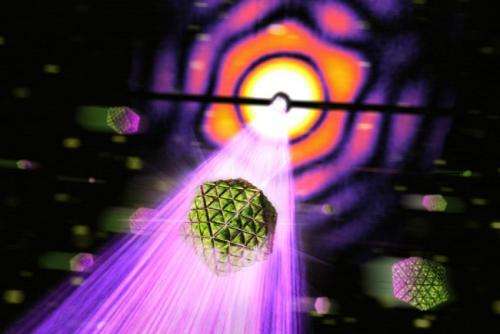Scientists X-ray tiny cell organelles responsible for carbon fixation

An international team of scientists led by Uppsala University has developed a high-throughput method of imaging biological particles using an X-ray laser. The images show projections of the carboxysome particle, a delicate and tiny cell compartment in photosynthetic bacteria.
The experiment, described in a paper published today in the scientific journal Nature Photonics, represents a major milestone for studies of individual biological structures using X-ray lasers. The technique paves the way for 3D imaging of parts of the cell, and even small viruses, to develop a deeper understanding of life's smallest units.
To test the method, scientists from Uppsala University, the European XFEL, DESY and a number of other institutions used the carboxysome. The carboxysome is a cell organelle for CO2 assimilation in cyanobacteria that has been extensively studied in Uppsala by Dirk Hasse and Inger Andersson. Carboxysomes contain protein machinery that incorporates carbon from carbon dioxide into biomolecules. About a third of global carbon fixation happens in carboxysomes.
The carboxysome is a tiny structure—only about 115 nanometres across, too small to clearly see with an optical microscope. A nanometre is a millionth of a millimetre.
Using a specially designed injector that produces a particle stream thinner than a human hair, the scientists sprayed an aerosol of carboxysomes across the beam of the LCLS X-ray laser at the SLAC National Accelerator Laboratory in the US. The scientists calculated the structure of the organelles by analysing the way the carboxysomes scatter the extremely short and ultra bright X-ray flashes of the LCLS. Up until now, this method required crystals of the sample material to get sufficient signal. Thanks to the extreme brightness of the X-ray laser and clever analysis of the diffraction patterns, the researchers could reconstruct individual samples without having to crystallise them. Carboxysomes like many other biological samples vary in shape and size and therefore cannot be crystallised.
Within 12 minutes, the researchers collected 70,000 scattering patterns from individual particles. The analysis returned an icosahedral shape (a structure with 20 triangle-shaped sides) for carboxysomes, in line with expectations. The results also showed considerable variation in size.
"Our method allows single-particle imaging of objects which can be different in size and shape", says Max Hantke, a doctoral student in molecular biophysics at Uppsala University in Sweden who led the research.
While electron microscopy usually requires samples to be frozen, X-ray lasers like the LCLS or the European XFEL, which is currently being built in Germany, can analyse biological samples without freezing. This method also offers the possibility to image whole living cells at unprecedented resolution.
"With the carboxysomes we have reconstructed the smallest single biological particles ever imaged with an X-ray laser, and we were also able to improve resolution. The reconstruction shows details as small as about 18 nanometres. For the first time we access a very interesting size regime with an X-ray laser. Large pathogenic viruses like HIV, influenza-, and herpes virus are in the same size domain as the carboxysome", says Max Hantke.
"These advances lay the foundations for accurate, high-throughput structure determination by flash-diffractive imaging and offer a means to study structure and structural heterogeneity in biology and elsewhere", says Professor Janos Hajdu, who is also one of the lead authors on the paper and one of Hantke's mentors as well as an advisor to European XFEL.
"Additionally, the size distribution of the carboxysomes before the experiment and what was seen in the resulting data matched almost perfectly", says Max Hantke, suggesting the organelles that were imaged were structurally intact.
While the intense X-ray pulse destroys the sample, an accurate diffraction pattern can be acquired before it disintegrates. This method, called "diffraction-before-destruction", was proposed in 2000 by the Uppsala group and was demonstrated with non-biological samples at DESY's FLASH facility in 2006.
Such single-particle imaging will be possible at the European XFEL when the facility opens to users in 2017. Two dedicated instruments will be available for such studies, the SPB instrument (Single Particles and Biomolecules) and the SFX instrument (Serial Femtosecond Crystallography), which will incorporate a similar sample injector to the one used in this experiment. With its 27,000 X-ray flashes per second and even higher intensity, the European XFEL will open up more opportunities and possibilities for researchers.
"In biology, there is heterogeneity at all levels, and we wanted a method for seeing it below the cellular level", says Janos Hajdu.
"We hope this research could lead to three-dimensional models showing the diversity of nanoscale cell parts", Max Hantke adds.
"These results show the way to high-throughput imaging of biological samples at high resolution. High data rates and very short exposures allow studies on the dynamics of particles and permit the analysis of structural variations, which are crucially important for life", says Filipe Maia, supervisor of Max Hantke.
More information: "High-throughput imaging of heterogeneous cell organelles with an X-ray laser"; Max F. Hantke, Dirk Hasse et al.; Nature Photonics, 2014; DOI: 10.1038/NPHOTON.2014.270
Journal information: Nature Photonics
Provided by Uppsala University




















